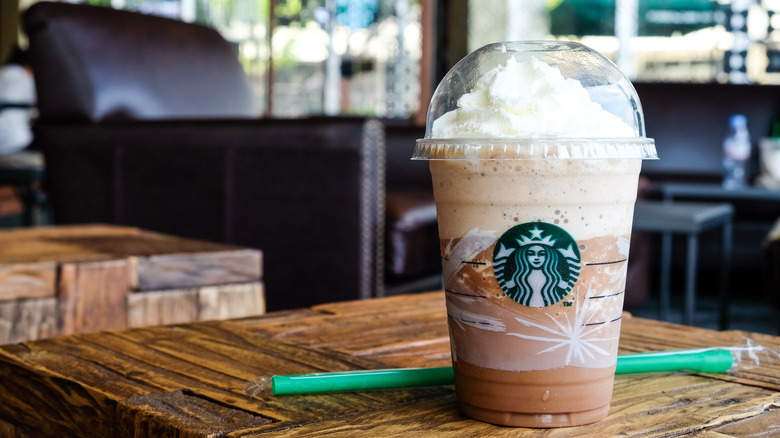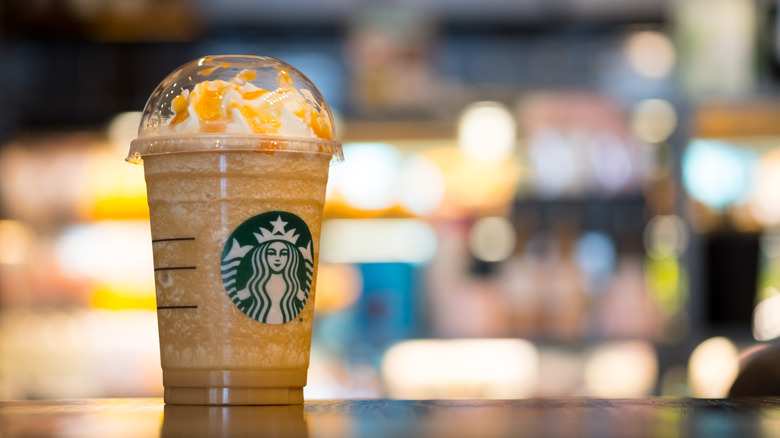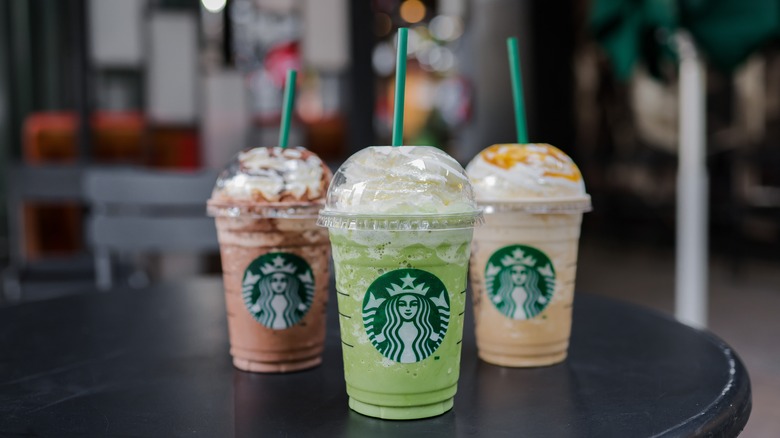The Evolution Of Starbucks Frappuccinos From One Drink To Endless Possibilities
The Starbucks Frappuccino is a staple — if you're looking for an ultra-sweet, coffee-infused, frosty drink, then the Frappuccino is for you. And there are so many variations to choose from — there are the classics, such as vanilla bean and java chip, but there are also countless secret menu Frappucinos as well thanks to the fact that Starbucks lets the customer add any syrups or milks that they want.
But it wasn't always this customizable. The history of the frappuccino dates back to the early 1990s when Starbucks wanted to create an iced blended coffee drink to meet customer demands. Employees began testing out recipes, and one particular creation ended up performing quite well during a trial run at a Santa Monica location. Then, Starbucks bought a Boston coffee shop called The Coffee Connection, which had a slushy-like drink called the frappucino; Once they had the the right to the name, Starbucks decided to use it for their own ice-blended concoction.
The Frappuccino officially made its debut in the spring of 1995 — but, unlike today, it only had two flavors: coffee and mocha. The original recipe contained just ice, milk, and espresso; The mocha flavor had chocolate syrup added. Neither flavor came with whipped cream on top, which, nowadays, many would argue is essential to the drink.
The Frappuccino options grew over the next few years
In 1996, Starbucks started selling bottled Frappuccinos, a move that certainly helped spread the word about the drink. But, it was in 1999 that the company made a change that helped cement the drink as a staple of their cafes: with the introduction of the caramel frappuccino, they also introduced the inclusion of whipped cream complete with caramel drizzle — and with it came the famous domed lid and green straw. This move proved pivotal — after all, when you think of a Frappuccino, you picture it topped with whipped cream, a domed lid, green straw, and all.
Starbucks then continued to expand the possibilities of the blended drink. In 2002, they introduced coffee-free versions of the Frappuccino, referred to as Frappuccino Creme. The flavors of Frappuccino Creme included vanilla bean and double chocolate chip. Then, in 2004, the company gave customers even more options with the introduction of Frappuccino Light, which they advertised as having between 30 and 40 percent fewer calories. This is because the light versions use nonfat milk (instead of whole) and have less syrup.
The light version proved to be the first step toward total customization, which would come a few years later.
The introduction of customizable frappuccinos
Starbucks brought the blended drink to a whole new level in 2010 with the introduction of However-You-Want it Frappuccinos. However-You-Want-It meant full customization: Customers could request any syrup, milk, or topping that they wanted without any extra charge. In other words, you could create your own preferred version of the drink on the menu. You could substitute regular milk for soy, add a chocolate drizzle to your vanilla bean Frappuccino, or request no whipped cream.
This, of course, made way for customers to get super creative with their Frappuccino orders, leading to widespread secret menu items and, more recently, concoctions that became TikTok trends. Some of the absolute best secret menu Frappuccinos include the strawberry shortcake Frappuccino (a strawberries and creme frap with the additions of vanilla bean powder, white mocha sauce, and toffee nut syrup with the whipped cream blended into the drink) and the candy-inspired Ferrero Rocher Frappuccino (a double chocolate chip frappuccino or java chip Frappuccino base plus mocha syrup, hazelnut syrup, and hazelnut drizzle).
Nowadays, you do have to pay for extra syrups and non-dairy milk, but the customizable Frappuccino has remained as popular as ever.


